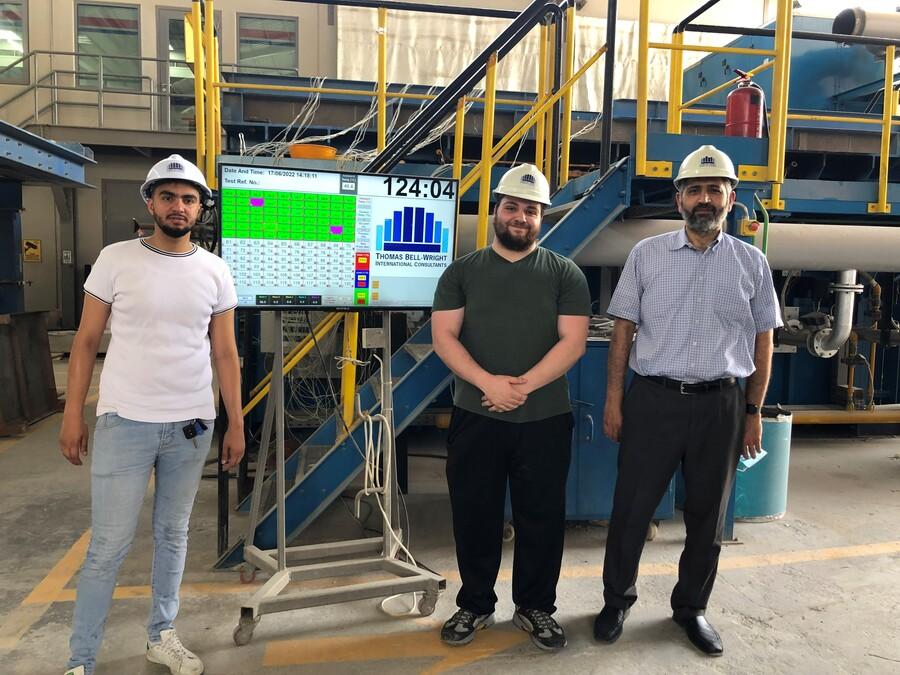- About
- Admissions
- Study at AUS
- Prospective Students
- Bachelor's Degrees
- Master's Degrees
- Doctoral Degrees
- Admission Publications
- International Students
- Contact Admissions
- Grants and Scholarships
- Sponsorship Liaison Services
- Testing Center
- New Student Guide
- File Completion
- New Student Orientation
- Payment Guide
- Executive Education
- Students with Disabilities
- Academics
- Life at AUS
- Research
- Contact Us
- Apply Now
- .

AUS researcher uncovers fire safety enhancements in ultra-high-performance concrete
Photo caption: AUS student Salem Khalaf and Research Assistant Yazan Alhoubi at the Dubai fire testing facility, where the research team tested their ultra-high-performance concrete’s fire resistance.
New research from American University of Sharjah (AUS) has revealed a significant advancement in fire safety for ultra-high-performance concrete (UHPC) structures. Led by Dr. Farid Abed, Professor in Civil Engineering at AUS, the study demonstrates how incorporating specific fiber types enhances UHPC’s resistance to fire-induced surface cracking and material breakage, a phenomenon known as spalling in the construction industry.
UHPC is an advanced construction material known for its exceptional strength, durability and versatility. However, its response to fire remains an area of limited study, prompting Dr. Abed and his team to investigate solutions that improve its fire performance.
The research, which was conducted through an experimental study, evaluated the impact of three fiber types—steel fibers (SF), a hybrid mix of steel and polypropylene fibers (SPPF), and polyvinyl alcohol fibers (PVAF)—on the fire performance of UHPC. A control column without fibers was also tested. All specimens were subjected to standard fire exposure based on the ASTM E119 fire test, a globally recognized standard that evaluates the fire resistance of building materials and structures under controlled conditions.
The team included several engineers, including Salem Khalaf, a master’s student at AUS, Yazan Alhoubi, a Research Assistant at AUS, Mohamed A. Moustafa, a Professor at New York University in Abu Dhabi and Mohammad Al Jamal, an engineer at e-construct company in Dubai, who provided the UHPC materials and fibers for the research.
Findings from the study revealed that incorporating fibers significantly improved UHPC’s resistance to spalling. Columns reinforced with SF and SPPF exhibited consistent surface cracking across all sides, while the PVAF-reinforced column maintained the lowest internal temperature, highlighting its superior thermal performance. These findings demonstrate the potential of fiber reinforcement to enhance fire resistance in concrete structures, a critical consideration for engineering and construction professionals, particularly those designing tall or slender towers commonly built in the UAE. The findings are also valuable for engineers and professionals addressing the impacts of climate change, particularly the increasing temperatures that may heighten fire risks in the region.
"Understanding the fire performance of UHPC with different fiber reinforcements is crucial for developing safer, more resilient infrastructure," said Dr. Abed. "Our findings contribute to the broader knowledge of how advanced construction materials respond under extreme conditions, helping engineers design structures with enhanced fire resistance, ultimately helping reduce damages in case of a fire.”
Dr. Abed’s new research aligns with his extensive work in sustainable reinforced concrete structures, fiber-reinforced polymers (FRPs), and fiber-reinforced cementitious matrix (FRCM) composites. In past research, he has collaborated with scholars from leading institutions worldwide and had his work on construction safety and sustainability published in several prestigious peer-reviewed journals. This research, titled “Effect of Fiber Types on Fire-Induced Spalling and Thermal Performance of UHPC Circular Columns,” was published in Elsevier’s Developments in the Built Environment, Volume 19, October 2024. It forms part of broader research being carried out at AUS’ Energy, Water, and Sustainable Environment Research Center, which supports research in sustainable engineering and resilient infrastructure, among other topics.
Dr. Abed has been teaching at AUS since 2008, where he is known for actively involving graduate and undergraduate students in his research, enabling them to gain hands-on experience in experimental design, analysis and academic writing. His mentorship has guided numerous students toward successful careers in engineering and academia.
AUS is ranked number one in the UAE and among the top 200 universities globally for civil and structural engineering (2024), according to QS World University Rankings by Narrow Subjects. Thanks to its cutting-edge research and innovation, AUS continues to advance engineering knowledge and practice regionally and globally.
For more information about the civil engineering program at AUS, visit www.aus.edu/cen/department-of-civil-engineering.

